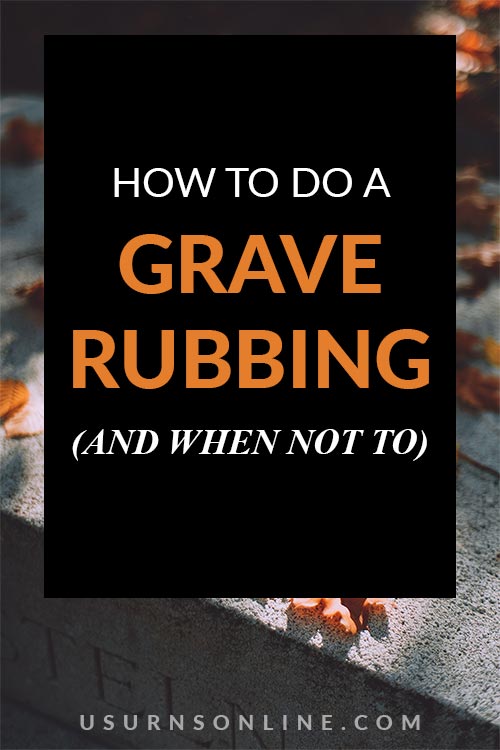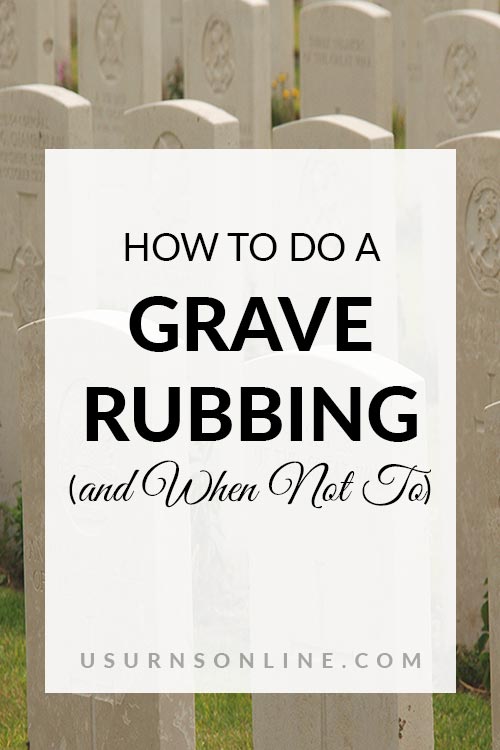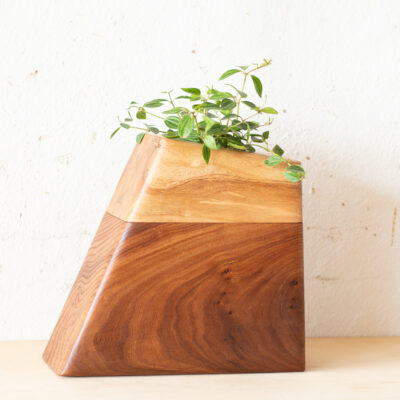Grave rubbing is a fun hobby enjoyed by many people. But it does raise some concerns…
Is a grave rubbing legal? Does it damage the headstone?
Are there laws or regulations concerning gravestone rubbing? Are there alternative ways to do the same thing?
So many questions to be answered! Read on, friends, and find out what you want and need to know about grave rubbings!
What Is Grave Rubbing?
A grave rubbing is an impression of a headstone produced by rubbing or grazing a soft pencil, crayon, or even a charcoal piece across a clean sheet of paper placed over a headstone.
Rubbing reproduces the inscription onto the paper, leaving you with a lovely memento of your visit to the cemetery, and a reference for historical or genealogical research.
If done properly, a rubbing can give you great details from the stone. Not just names and dates, but artwork too. Many gravestones are a work of art, not to mention the historical information contained on them.
So headstone rubbing is a simple way to create your own artwork while recording a small slice of history. Not only is it easy to do, but it is also a great way to increase your knowledge on genealogy.
Many people use headstone rubbings in their ancestry and genealogical research. As you visit family members at cemeteries, you’ll discover fresh links between your present and your past. It helps you connect the dots, so to speak.
Does rubbing harm the headstone?
Rubbing gravestones has been done for many years. But this technique can be very abrasive to headstones.
Urns Made in the USA
Gravestone rubbing can cause serious damage to a marker. You must use caution and care when making a rubbing. It is imperative to avoid damaging the monument with your techniques. Avoid all harsh chemicals and stiff-bristled brushes. Never perform a rubbing on a headstone that is in poor condition.
If you tap on a headstone and it sounds hollow, avoid doing a rubbing on it.
Depending on the material a gravestone is made from, stones will deteriorate in different ways. Marble disintegrates, slate divides into thin sheets, and the list goes on. If a stone is unstable, you can end up knocking it over and breaking it. The loss of history would be heartbreaking to you as well as the family the marker belongs to.
The rubbing utensils you use can also cause damage to a marker. If a utensil breaks through the paper, it can scratch the stone or even stain it. Crayon can be especially hard to remove from the stone.
Is grave rubbing legal?
Gravestone rubbings, even when done properly, can cause damage over time. That is why this practice can be controversial.
The legality will vary depending on location. Always check with the cemetery itself, and of course use common sense. Some headstones might be too fragile. The practice has been banned in some states and many graveyards and cemeteries.
Cemeteries that have restoration projects going on, or locations designated as historic landmarks will often ban rubbings – but not always.
Is grave rubbing respectful to the deceased?
It is vital to respect the graves. Touching headstones and monuments can be considered very disrespectful in some cases, especially if it causes damage.
But opinions are divided on the art of grave rubbing. It’s an important, beautiful, and meaningful way to record history. It’s a fun hobby that gets people interested in ancestry and bygone times. Many taphophiles enjoy headstone rubbing as a hobby.
After all, what’s the point of a cemetery if no one visits, records, researches, and remembers? The practice of creating headstone rubbings can truly be a way to show honor and respect to the dead.
Still, repeated rubbings can harm the monuments. The best rule of thumb is to ask before you rub.
Would a photograph of the headstone be better?
Photographs are so detailed that it can negate the need for rubbing a headstone. But… the digital photograph, while valuable as its own form of art, is not the same as a physical reproduction via rubbing. That piece of paper was in contact with that headstone. It’s a literal, tangible connection with history.
Also, some cemeteries do not want photos taken as a matter of privacy and/or reputation management. Always get permission and follow the rules.
What are other terms for grave rubbing?
Rubbing has several synonyms, each essentially means the same thing:
- Frottage (French for “rubbing”)
- Stone rubbing
- Gravestone rubbing
- Headstone rubbing
- Tombstone rubbing
- Rubbing
How to Do a Grave Rubbing
Now that we know all about grave rubbing, let’s look at how to actually do it.
Step 1
Before leaving home, check that it is okay to make a gravestone rubbing. Call the cemetery office or check on their website. In other words, get permission.
Step 2
Gather your needed items before you leave home. You don’t want to get to the cemetery and find you have left important tools at home. (See below for a supply list.)
Step 3
Find the gravestone. You may have to get a cemetery map if you don’t know where the particular marker is that you want to rub.
Find a Grave is a valuable resource to help you discover cemeteries and specific graves.
Step 4
Clean the gravestone. Begin by using a soft brush to take off the easiest dirt build-up, and if needed, spray with water and wipe gently.
Only clean enough to show the distinct features on the headstone. Avoid scrubbing or any action that would damage the stone.
Step 5
Place a of plain sheet of paper (or interfacing fabric) over the desired markings.
You will want to cut off any extra paper. Leave a little edge around the back of the headstone. The edge makes it much easier for you to tape it in place and give the paper some stability.
Step 6
Keep the paper in place while you tape it on to the headstone using painter’s tape. Avoid taping over any eroded areas of the stone. The tape will lift out crumbling stone when you remove it.
You can also use a large rubber band to go around upright headstones in place of tape.
Step 7
Start rubbing. You can use wax, crayon, charcoal, or chalk. Start from the outer edge of the grave marker and work your way inward. Make sure you get text and patterns as you rub. You will continue rubbing until the design depth is to your liking.
Be careful not to break through the paper and mar the headstone.
Step 8
When you have finished, carefully remove the tape from the back of the headstone.
Roll your rubbing and place it in a poster tube or secure it with a rubber band.
Once you get back home, you can decide how you would like to “finish” your project. There are ways to display it. You can attach it to a stiff cardstock, frame it, tack it directly to your wall, or scan it into your computer.
Grave rubbing supplies
Pictured above, you see a complete grave rubbing kit that has everything you need to do a rubbing. The kit includes:
- Five sheets of spacious 27″ by 36″ paper designed for rubbing transfer
- Carrying/storage tube for the paper
- Two 1/8 lbs pigmented rubbing waxes in black and rust colors
- Specially designed masking tape
- Natural bristle brush for cleaning debris
- 16-page headstone rubbing guide
DIY supply list
The kit above is pretty much all you need. You can create your own kit and modify it as needed, with more or less items depending on what you want to do and the look you’re going for.
There are three things you need:
- Some type of paper (or special fabric)
- Something to draw/rub with
- Rubbing wax (in multiple colors!)
- Charcoal
- Crayon (this is ok, but rubbing wax is much better)
- Chalk
- Drawing pencils
- A gentle adhesive to hold the paper in place
- Masking tape (can leave residue)
- Painter’s tape (ideal option; choose “delicate surface” version)
- Rubber bands (these oversized bands will fit over many upright headstones)
That’s it! But you’ll make your time easier and more productive if you have some of the following:
- Poster tube (to roll up and store your rubbings without folding)
- Scissors (to cut your paper or fabric to size)
- Soft-bristle cleaning brush to remove debris
- Spray bottle with water and rag to remove more stubborn debris
Headstone Rubbing Etiquette
Here are some common courtesy tips:
- Obscure the decedent’s name if they are not your family member.
- It is poor practice to take pictures of ongoing funerals, or do a rubbing near a service. Give them some space.
- Don’t touch or move mementos or flowers.
- Avoid walking on the graves.
- Don’t take photos of other visitors in the cemetery.
- Bring as little gear as possible.
More: 10 Things NOT to Do in a Cemetery
When to avoid grave rubbing
- Don’t undertake to rub any deteriorating marble, sandstone, unsound, or weakened stone.
- Avoid any unstable, wobbly, or flaking stone.
- Please don’t do a rubbing when it is illegal.
What to Do Instead of Grave Rubbing
- Take photographs
- Draw, paint, or sketch the headstones
- Record the information in a notebook or cemetery journal
- Make foil castings: Place a thin sheet of foil against the stone. The cheaper and thinner foil works best for this method. Using a lightweight brush, gently press the foil into the carvings of the stone.
If the state or cemetery laws prohibit the making of a grave rubbing, a photograph is the best alternative. Some cemeteries don’t even allow tombstones to be photographed without the permission of the sexton. In that case, you can still sketch.
If you take anything away from this article, I hope you get these two things:
- Get permission before you do a grave rubbing or photograph! and
- Enjoy visiting cemeteries, looking at gravestones, researching genealogy, discovering history!
Read Next: What is the Death Positive Movement?
Pin It







I’ve Been Wanting To Do Grave Stone “Smudging” For So Long and Just Wasn’t Exactly Sure How To Go About It! You Gave Me A Lot Of Important and Greatly Appreciated Information Especially About Respecting Headstones and Making Sure It’s Legal Before Doing A Smudging! Thank You!
I take pictures of the headstones of the family for the grandchildren and their children to go by, if ever they go looking for their ancestors…Never heard it could be prohibited…Since most plots and headstones were paid by me, I don’t see why I couldn’t take a picture of something I purchased with my hard earned money…Always thought once you buy it, it’s yours…That would be quite a problem for the cemetary if i have to sell the plots for profit and use the extra to pay for the moving my loved ones to a place less troublesome for the family…They already got me with the, only fresh flowers and no decorations rule…